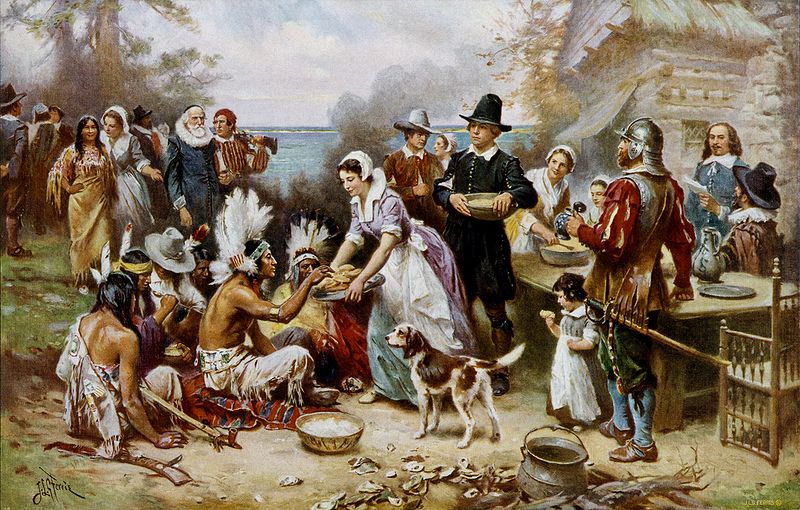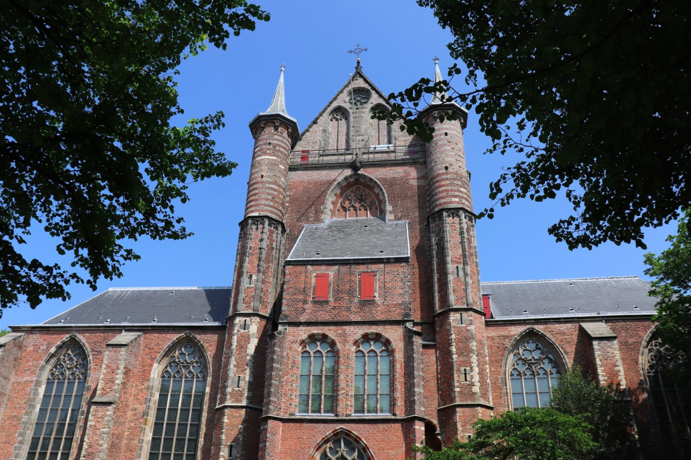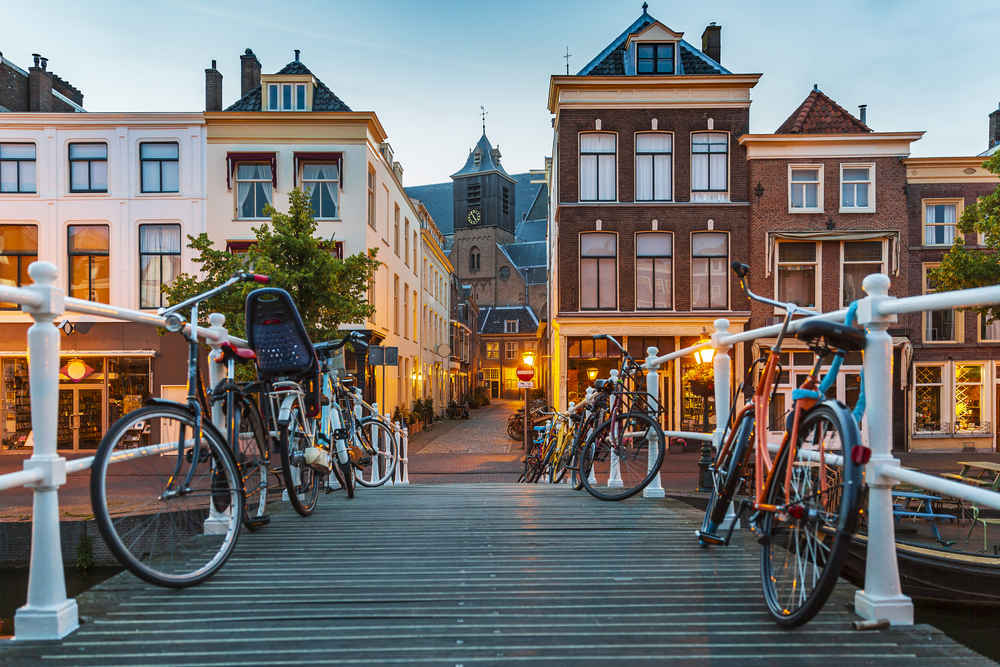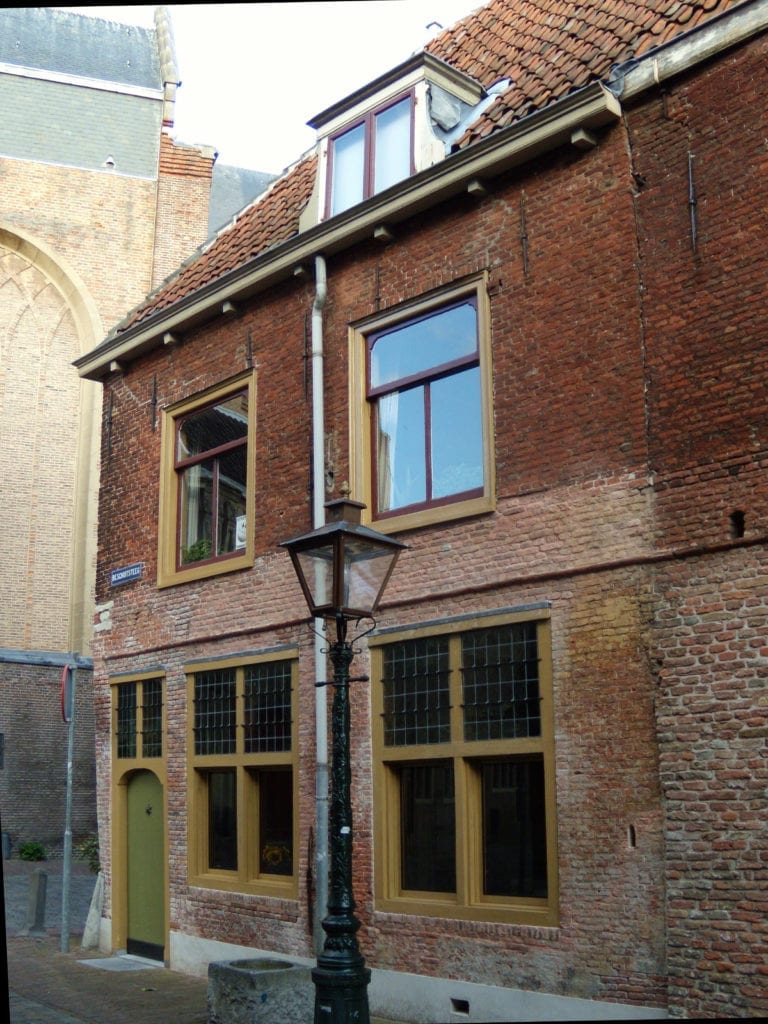You may very well know by now how the Dutch like to spend their Christmas and Sinterklaas holidays, but how do they celebrate Thanksgiving in the Netherlands?
You might be thinking, “Um…they don’t?” but wait just one turkey-day minute, dear reader! Haven’t you ever heard about Leiden’s Thanksgiving history? *adjusts glasses* Well, then, let us teach you. 🤓
The history of Thanksgiving
For those who don’t know much about Thanksgiving, here’s the basic story: in the 17th century, a bunch of Pilgrim colonists sailed their ship (the Mayflower) to North America, fleeing religious persecution in England.
There, they celebrated their first corn harvest by sharing a feast with the friendly Native American tribe, who taught them how to farm the land. The end!

Well, not really. Thanksgiving is one of the most popular American celebrations — and well-known around the world. It is celebrated on the fourth Thursday in November, and is associated with being thankful and charitable.
READ MORE | The pilgrims in Leiden: Where were the pilgrims before they sailed to America?
But to foreigners, what most stands out is the image of the typical American family seated around a dinner table filled with delicious dishes and a giant cooked turkey. 🍗
So what role did Leiden play with regard to Thanksgiving?
“Hold up!” we hear some of you Dutchies cry. “You left out the part where the pilgrims came to the Netherlands for over 10 years.” And it’s true — most of us have never heard the full story of Thanksgiving.
History teachers tend to leave out the fact that before the pilgrims arrived in Massachusetts, they first stopped in the Dutch city of Leiden, and stayed there for a long time — though who could blame them? That’s what most of us foreigners living in Leiden have done! 🤣

One of the main reasons they fled to the Netherlands was because the Dutch were more accepting of their religious practices.
The Dutch Republic (Republiek der Zeven Verenigde Nederlanden) certainly seemed more appealing than the disparaging eyes and unwavering religious beliefs of the English.
Why did the pilgrims leave Leiden?
The pilgrims actually went to Amsterdam first, where it all was going smoothly for a while. After spreading out to live in Leiden and building new lives, the Pilgrims realised that they were changing too much. Worse: they were losing their religion.

They were grateful for everything given to them here but were struggling to adapt to the Dutch culture, which was now too liberal for their liking.
READ MORE | Dutch-American history: how the Netherlands played a pivotal role in America’s Independence
William Bradford, Plymouth’s faithful Pilgrim and Colony governor, said they were being “…drawn away by evil examples into extravagance and dangerous courses.” 👀
Jeez. He really didn’t agree with the “immoral” Dutch ways. So, fearing this would be the end of their congregation if they didn’t move on, the Pilgrims decided to head to America. ⛵
A celebration of life and unity
In 1620, the pilgrim’s emigration from Leiden — where they had worked for about 12 to 20 years — truly began.
They left Leiden via the canals and transferred onto a leaky “Speedwell” (a ship built in 1577) in Delfshaven. Then, they finally boarded the famous Mayflower in Southampton.
Ultimately, the actual time span between the pilgrims leaving England and finally completing their famous voyage and the great feast is pretty long.
Today’s “day of thanks” in Leiden
It was during the Civil War, between 1861 and 1865, that President Abraham Lincoln declared Thanksgiving a national holiday. Nowadays, Thanksgiving is a time for reflecting on the people and things in our lives we are most grateful for. 🙏🏻
What better reason to come to Leiden than to celebrate Thanksgiving, spending a day exploring the pretty canals and cobbled streets? From its tiny alleyways to its wide-open roads, Leiden is a city that can sometimes feel much smaller than it is (in the best way).
Every year in Leiden, there is a Thanksgiving Day Service held at the Pieterskerk, a beautiful church. One of the pilgrim leaders, John Robinson, is actually buried here, which makes it all the more interesting to visit. Or slightly creepy. Or both.
Pilgrim and Thanksgiving spots to check out in Leiden
The city is home to the Leiden American Pilgrim Museum, a cute little medieval house dedicated to the Pilgrims (located on Beschuitsteeg, near the bell tower of the Hooglandse Kerk church).
It’s an old building full of furniture, books, maps, engravings, and other materials from the Pilgrim times. It’s meant to recreate how these people lived in England, Leiden, and New England.

You’ll also find a memorial on the ruins of Leiden’s Vrouwekerk (AKA “lady’s church”), which the museum helped install. The bronze engraving commemorates the history of the church and its connections with the Pilgrims. 💁♀️
In the rest of the Netherlands, thanksgiving isn’t that big of a deal — but many American expats are bringing the traditions a little closer to their origins.
If you want to celebrate Thanksgiving in the Netherlands, you can find traditional meals (turkey, mashed potatoes, vegetables and gravy) at restaurants across the country.
Grab your friends and family and enjoy! Lekker!
Now you know a little more about this not-so-American holiday. Do you have any fun facts about the pilgrimage? Let us know in the comments below!
Feature Image: Stedelijk Museum De Lakenhal/Wikimedia Commons/Public Domain




Actually, this is not exactly accurate. Thanksgiving is a National day of mourning for many American Indians. These Pilgrims were not so friendly as we’ve been told. This is why many Native Americans today do not celebrate the landing of the Pilgrims or the European settlers who came after. The history is horrendous – for the Indian and is conveniently forgotten by the West. The Native Americans lost their lands, were treated like animals, and were moved from one reservation to the next until by circa 1896 about 90 percent of the Indians on the American continent died off from starvation or worse, by destroying their culture, their ways to exist off the land which was tied into their spiritual beliefs. There are no historical documents that any Native Americans were invited in 1621. After the alleged celebrations, relationships between the Pilgrims and the Indians deteriorated and led to many wars. Squanto, the Indian allegedly to have aided the Pilgrims was later sold into slavery in Spain. Nice people, hey? (source: The New York Times, ‘Most Everything You Learned About Thanksgiving Was Wrong’). Most people need to start reading the histories of the world they were never taught in school. Even a history Masters student at university has to dig deeper since the syllabuses will only list the'” appropriate” books the professor believes are relevant, which usually omit the other side of the historical explanation.
At the service at Pieterskerk on 22nd November I am willing to wager they will only talk about the “merciful” Pilgrims and Europeans. But nothing about how they grabbed the land Native Americans lived for thousands of years on. Myths are much more pleasant.
Nice one Sir. This is the truth of ignorance of people for whom the rest of the world are but slaves and highly regard their superiority complex over all else. By the way first time in EU was so unwelcoming and horrendous for many of us. It seems to be the culture…
Nice compilation with impressive photography.
Re the comment of Diderot: There is indeed some historical oversimplification in the account on this webpage, but myth busters would be well-advised to avoid creating new myths themselves. Squanto was a slave in Spain years before, not after, the Massachusetts Thanksgiving of 1621 (as a careful reading of the referenced New York Times article will show). There are indications that Indians did participate in some fashion in the feasting then. “Merciful” is not an adjective widely applied to people in colonial New England. The tragic and shameful history of what befell native Americans after the arrival of Europeans is indeed not well-understood by most or at least many people, but it has been extensively researched by scholars, and the history is multifaceted, not simply a matter of just two “sides,” one mythical and well-known, the other real and mostly unknown.
Was there a lawsuit about 1910 where the house of Orange would have fallen if it wasn’t settled in ownership? Doing ancestor research!
Thanksgiving day in Dutch is ‘Dankdag’ in Dutch and is celebrated with a church service in many Dutch churches. In spring, these churches have services for ‘Biddag’ when they pray to God for a successful crop.
Great article, but Thanksgiving is the FOURTH Thursday in November (not Third as stated).
In the USA, 4th Thursday as introduced by Lincoln. I believe that the article is referencing practices in The Netherlands.
There was a period when the “correct” day for Thanksgiving in the U.S. was not codified. Since November has four Thursdays five out of seven years, on average, Thanksgiving falls both on the fourth and the last Thursday of the month, except in years when November begins on a Wednesday or Thursday. In my father’s lifetime (He was born in 1904) some celebrated on the fourth and some celebrated on the last Thursday. H
The more hedonistic observed two Thanksgivings in those special years when there were a fourth and fifth Thursday.
I’d love to hear restaurants names that serve ThanksgivingISH food??
The native peoples were practicing cannibalism (supposedly including a shipwrecked Dutch sailor in Florida who was eaten by the Timucua people), slavery and even scalping before the Europeans arrived The Iroquois Confederacy had a big battle every year against an alliance of Algonquin peoples and those captured were tortured to death. The Europeans did not introduce horror and ugliness. The Pilgrims were rural people trying to live in an industrial city. if they had gone to the rural areas of the Netherlands, particularly dwelling among the Mennonite areas in Friesland, they might have been happier. Also their leader recorded two offers by Dutch business concerns to settle them at the mouth of what is now the Hudson River. Offer included transpiration, protection, animals, tools, grain, food. The only thing was they had to be under the Dutch flag. If it were me, i would be blowing the ink dry after signing the agreement before the offer makers realized how much they had given away. BTW the first documented European to advocate peaceful and fair relations with the native peoples was Frisian, David Pitersz de Vries.
Nice article! My daughter lives in The Hague and we visited Leiden last year. Love the Netherlands…
For an excellent, eye-opening, historical account of The Dutch and America, I sincerely recommend your reading “The Island in the Center of the World” by Russel Shorto. Mr. Shorto, an American writer, knows Leiden and the Dutch story very well. He is also the director of the John Adams Institute in Amsterdam.
So when did Thanksgiving start? No mention of it while they were in the Netherlands.
Another factoid missing is that only part of the 102 passengers of the Mayflower were from Leiden. The others were from England. There were originally two ships, one for Holland and one from England. Since one was leaking and not sea-wothy, the passengers decided to all share the Mayflower and they travelled in very cramped quarters for over 60 days. The idea was to go to Virginia, where a colony already existed, but they only made it as far as Cape Cod and decided to stay there for better or worse.
Thank you for this history! My Dutch great grandmother on my mothers side came from Amsterdam to Detroit and married an Armenian there. 70 years later my father moved to Brussels and i joined him for 18 months. This is where I cooked my first American Thanksgiving spread in 1996. We ordered a turkey from a specialist bird butcher and had friends returning fron US business trips bring an aluminum turkey pan, turkey baster and a can of yams. It was the best turkey I’ve ever made.